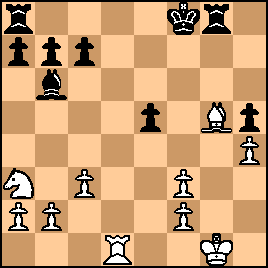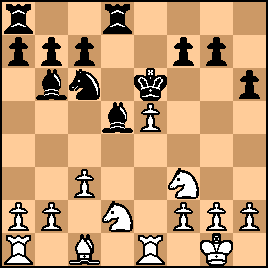|
< Earlier Kibitzing · PAGE 3 OF 3 ·
Later Kibitzing> |
| Mar-12-08 | | johnlspouge: Wednesday (Medium/Easy): White to play and win
Material: N for B. The Black Ke7 blockades the passed Pe6, which is backed by Re1. The K is a particularly vulnerable blockader. The Re1 is on the same file as Ke7. The Rd1 opposes the Rd8 behind Ne6. The Black Qb3 cannot contribute rapidly to the defense of Ke2. The Qg3 has an entry point at d6, presently occupied by Nd6 and covered by Rd8. Candidates (29.): Nc8+
29.Nc8+, to deflect Rd8 and unblock e6 for Qg3.
Black could try accepting the sacrifice.
29...Rxc8 30.Qd6+ Ke8 31.Qd7+ Kf8 32.Qf7#
Black must therefore decline.
29...Ke8 [Kf8 30.e7+] 30.Rxd8+
Black has two possibilities for recapture.
(1) 30...Bxd8 31.e7 (threatening 32.Nd6+ and 32.exd8=Q) Black loses at least a B.
(2) 30...Kxd8 31.e7+ Kxc8
[31...Ke8 32.Nd6+ and 33.e8=Q, winning a R for a P]
32.e8=Q, winning the exchange for P, with a violent attack |
|
| Mar-12-08 | | GibGezr: I found the same as TheBB:
29. Nc8+ Rxc8 30. Rd7+ Ke8 31. Qd6 Rg7 32. Rxb7
At that point, I stopped looking. |
|
| Mar-12-08 | | whiteshark: Ask <How can I get my ♕ to d6 or c7?> Thereafter it's easy to find the solution. |
|
| Mar-12-08 | | zb2cr: 29. Nc8+ is the dynamite move needed to bring down the walls of Black's position. Black's best is 29. ... Ke8; 30. Rxd8+, Bxd8 (30. ... Kxd8; 31. Qd6+ leads to a quick mate); 31. e7, Bb6; 32. Qb8! looks like a win to me. |
|
| Mar-12-08 | | kevin86: I take 90% credit on this one. I saw what would happen after the capture at c8,but didn't check into some of the nuances if black refused the sac at c8. It does look rather a lost cause for black,however. |
|
| Mar-12-08 | | YouRang: Got it! Here, it seemed fairly clear that we would want to bring our queen into the attack, and for that, we need to get our knight out of the way. This has all the earmarks of a clearance sac. The obvious try is 29.Nc8+, which has several nice benefits: (1) it vacates d6 for our queen, (2) by giving check, it's forcing, (3) it cannot be taken since 29...Rxc8? leaves d6 wide open for the queen and quick mate. (I was surprised to see that black took it anyways, as the resulting mate-in-3 is quite easy to see.) This would force 29...Ke8 or 29...Kf8. There are a few variations that can come out of this, but basically they all lose to subsequent Rxd8 and e7, with the queen coming into the attack on the d-file. Good Wednesday puzzle. |
|
| Mar-12-08 | | UdayanOwen: Hey guys, for anyone who is thinking of not checking out the game of the day, THINK AGAIN, just in case you don't know there is a SWEET classic by Najdorf.... He allows a bishop to be trapped on move 11, and ends up sacking two pawns and all four minor pieces to mate on move 22! |
|
| Mar-12-08 | | Duque Roquero: 29. ...Rxc8? What a bad move. The mate is too obvious. |
|
| Mar-12-08 | | mworld: yeah, i was very surprised when i saw 29...Rxc8 myself |
|
| Mar-12-08 | | Steve Case: Should've been a Monday offering as I got it move for move (-: |
|
| Mar-12-08 | | wals: Noting think:- "fire in the hole""
forward to TPOTD
The black King is in a vulnerable position on the seventh.(Love that talk, makes me feel all professional).
and is subject to check by Nc8 which wraps it up so far as I can see. 29.Nc8 ...Rxc8 30.Qd5+ ...Ke8 31.Qd7+
29.Nc8 ...Ke8 30.Rxd8#
PM=
Victory celebrations |
|
| Mar-12-08 | | ellhares: <mkrk17: I actually thought of taking black's queen by Ra1 and then Ra3. Looked to me like black cant do anything abt it.> Ra1?? very bad move loss imediately after Bc7 and black in very good position now |
|
| Mar-12-08 | | ellhares: the strang here that i cant beleive that these game was played in 1801 its similar to modern chess ine the early period of that centurey!! |
|
| Mar-12-08 | | Jason Frost: I thought this was pretty obvious for a thursday, untill I realized it was Wedensday. |
|
| Mar-12-08 | | ounos: >D.Observer: Why not 14. ... O-O?
15. Qg5 or 15. Qh4 is pretty much over. |
|
| Mar-12-08 | | zb2cr: <ounos>,
In your comment replying to <D.Observer>, you wrote: "15. Qg5 or 15. Qh4 is pretty much over." Not really. Either of those moves is met by 15. ... Nd8 and Black has time to defend the threatened mate by ... Ne6. Much simpler is 15. Qxd7--castling away has left the Black Queen hanging. |
|
| Mar-12-08 | | UdayanOwen: <wals: The black King is in a vulnerable position on the seventh.(Love that talk, makes me feel all professional).> Thanks for providing this funny... :)
<Wals continued: 29.Nc8 ...Rxc8 30.Qd5+ ...Ke8 31.Qd7+29.Nc8 ...Ke8 30.Rxd8#
PM=
Victory celebrations>
What about your brain score? Well the celebrations were perhaps a bit premature since 30.Rxd8# is actually met by 30...Bxd8 or 30...Kxd8. However, for finding the first two moves of the main line, I will take the liberty of awarding you .25 per hemishphere. Then I will throw in a humour bonus for your right hemisphere, for all the mirth you provide to <CG>: Brain score:
L = .25, R = .75 |
|
| Mar-12-08 | | MostlyAverageJoe: <ellhares: <mkrk17: I actually thought of taking black's queen by Ra1 and then Ra3. Looked to me like black cant do anything abt it.> Ra1?? very bad move loss imediately after Bc7 and black in very good position now> Nonsense. 29.Ra1 Bc7 leads to a forced win by white, although <mkrk17>'s would have to change his plan of playing Ra3. Here's how: 29. Ra1 Bc7 30. Nc8+ Rxc8 31. Rd7+ Kf8 32. Rxc7 Qb6 33. Rxc8+ and while this (brain-produced) line looks good enough for a win, Hiarcs claims a forced mate: 33 ... Kg7 34. Rxg8+ Kxg8 35. Rd1 Qc6 36. Qb8+ Kg7 37. Rd7+ Qxd7 38. exd7 b6 39. d8=Q a4 40. Qg8+ Kh6 41. Qg6# Should black play something else, e.g., 29...Rg7, then 30.Ra3 wins the white Q for a rook and the game (although there are more forcing lines for white). So yes, <mkrk17>'s ideas works OK. |
|
| Mar-13-08 | | euripides: <MAJ, ell>
I posted the following comment earlier: <Against 29.Ra1 Black might play 29...Bc7 and if 30.Ra3 then Qb6, saving the queen and organising some sort of defence. If <29.Ra1 Bc7> 30.Nc8+ Rxc8 31.Rd7+ Ke8 32 Rxc7 Rd8 White still looks much better but it doesn't look as decisive as the game.> <MAJ> Not sure where you started your computer analysis, but Black's 31st and 32nd are not obvious to me in your 'brain-produced' line <29. Ra1 Bc7 30. Nc8+ Rxc8 31. Rd7+ Kf8 32. Rxc7 Qb6 33. Rxc8+> |
|
| Sep-11-09 | | WhiteRook48: 29 Nc8+ clearance |
|
| Dec-26-18 | | HarryP: Nice game. |
|
Nov-19-22
 | | Sergio X Garcia: Fuego en el agujero! |
|
| Jan-08-23 | | generror: Another Atwood - Wilson game, but apparently Wilson has given up trying to refute the Del Rio Attack. He now plays a kinda respectable opening, but gets himself into trouble with <11...g6?> -- the g7-pawn actually is actually poisoned, and after <11...Qd7! 12.Qxg6?? 0-0-0 13.Qf6 Rhg8 14.g3 Qh3> (D) threatening <15...Rxg3+! 16.hxg3 Qxg3+>, it's White who is in deep trouble.
click for larger viewWhite plays really well, although Black could have equalized after <18.h4?> by <18...Kf8!>, threatening <...gxh4>, and after <19.Bxg5 Nxe5 20.Bh6+ Ke7 21.Bg5+ f6 22.Rfe1 Kf8 23.Rxe5 Qxe5 24.Qxe5 fxe5> (D). 
click for larger viewHowever, after the horrible and utterly nonsensical <20...c5?>, which does nothing but blocking his strongest piece, the bishop on b6, Black is on the way to disaster. After <25...Rad8?>, White misses a mate in 7 with <26.Nf5+>, it's mate in 13 anyway after <28...f6?>, although here Black chooses the quick and painless way by accepting that nice knight sacrifice <29.Nc8+!>. It's kinda funny that just like in their previous Del Rio games, this one also ends up with another devastating white pawn on e6. |
|
Jan-08-23
 | | perfidious: <generror>, in your proposed line 11....Qd7, how does Black defend the loose bishop after the simple 12.Qxd7+ Kxd7 13.Rd1? |
|
| Jan-09-23 | | generror: <perfidious> Thanks for the comment, that is an interesting question with an mind-boggling answer! According to Stockfish (who I must admit is a slightly better player than me ;), the only non-losing move is <13...Ke6>. It does look alarming, but the Stockfish line <14.Nd2 Rhd8 15.Re1 h6> (D) and now White has the choice between various edge pawn pushes, all leading to very equal positions (if anything, with a slight advantage for black). 
click for larger viewI guess that e5-pawn -- as quite often -- actually is the best protection the king can get, and that Black's development lead helps him to fend off any attacks White may try. But what's really mindboggling is that on <14.Ng5+>, Black even can apparently simply eat that pawn via <14...Kxe5!?> (D), and *still* seems to be safe on the middle of the board! 
click for larger viewThe Stockfish line continues <15.Nd2 Rad8 16.c4 Be6 17.Re1+ Kf5 18.Ndf3>. Now Stockfish initially thought <18...Ba5?> was best, but it turns out White gets an advantage after <19.g4+! Kxg4 20.Re4+> (D), but even then things are not as clear as the diagram might suggest. 
click for larger viewHowever, <18...Nd4> leads to complete equality via <19.Re5+ Kg6 20.Nh4+ Kf6 21.Bf4 Nc6 22.Re4 Bf5 23.Nxf5 Kxf5 24.g4+ Kxg4 25.Nxf7 Kf5 26.Nxd8 Kxe4 27.Ne6> (D), and here I as human player agree that it's equal. 
click for larger viewIt was also interesting to see that the Black position actually seems to be pretty robust; it's not that you have to play exactly these moves in order not to lose immediately as Black, and I'd say White needs to be more accurate in order to maintain equality. I'd still feel very uneasy having to play these lines :) |
|
 |
 |
|
< Earlier Kibitzing · PAGE 3 OF 3 ·
Later Kibitzing> |





